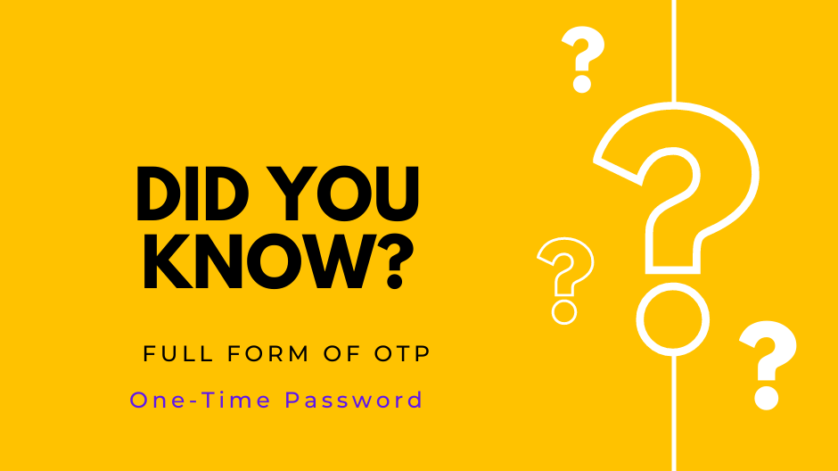OTP Full Form
In today’s world, online security is of utmost importance, and one of the most common tools used to secure online transactions is the OTP or One-Time Password. OTPs are used to add an extra layer of security to online transactions, and they have become a popular method for authenticating & securing online transactions. Let’s explore more about OTP Full Form.
Defining OTP
An OTP is a unique alphanumeric code that is generated for a specific transaction, and it is valid only for a single use. OTPs are generated by a computer algorithm and sent to the user’s registered mobile number or email address. Once the user receives the OTP, they have to enter it into the required field to authenticate the transaction.
OTP, or One-Time Password, is a dynamic and unique code generated for a single transaction or login session. Unlike traditional passwords that remain static, OTPs change with each use, providing an additional layer of security. The primary purpose of OTPs is to enhance authentication processes by ensuring that even if a password is compromised, unauthorized access is limited.
In the era of digital communication and online transactions, security is a paramount concern. As technology advances, so do the methods employed by malicious actors to compromise sensitive information.
How OTP Works
There are two types of OTPs – Time-Based OTPs and Event-Based OTPs. Time-Based OTPs generate a new code every few seconds, while Event-Based OTPs generate a new code every time a specific event occurs, such as a user logging in or making a transaction. OTP can be generated through various methods, each designed to fulfill specific security requirements. Some common methods include:
SMS-based OTPs: A randomly generated code is sent to the user’s registered mobile number via text message. This code is typically valid for a short duration.
Token-based OTPs: Users carry a physical device, often referred to as a token, which generates a unique code at regular intervals. This code is synchronized with the server to ensure authentication.
App-based OTPs: Mobile applications, like Google Authenticator or Authy, generate time-sensitive codes for authentication. These apps are linked to the user’s account and provide an extra layer of security.
Email-based OTPs: A one-time password is sent to the user’s registered email address. This method is commonly used for account recovery and additional verification steps.
Applications of OTP
OTP is a highly secure authentication mechanism, as the code is valid for only one use and only for a specific period. If someone gains unauthorized access to the OTP, they will not be able to use it again, and it will be useless for any further transactions. To use OTPs, users need to register their mobile number or email address with the service provider. Once registered, the user will receive an OTP every time they perform a transaction or access sensitive information. The OTP is sent via SMS or email, depending on the user’s preference.
Online Banking: OTPs are extensively used in online banking to authorize transactions, log into accounts, and enhance overall security.
E-commerce Transactions: When making online purchases, users often receive OTPs to confirm the legitimacy of the transaction.
Two-Factor Authentication (2FA): OTPs are a crucial component of 2FA, requiring users to provide a second form of verification in addition to their passwords.
Account Recovery: In cases of forgotten passwords or compromised accounts, OTPs play a pivotal role in securing the account recovery process.
Secure Login to Applications: Many applications and platforms use OTPs to ensure secure access, protecting user accounts from unauthorized entry.
Benefits of OTP
One of the significant benefits of OTPs is that they are easy to use and require no technical knowledge. Users only need to enter the code they received to authenticate the transaction. OTPs are also cost-effective and do not require any additional hardware or software.
The purpose of OTPs is to protect against fraud and unauthorized access to sensitive information. They are commonly used for online banking, e-commerce transactions, and other types of online transactions that involve sensitive information. OTPs are also used to verify the identity of users before they can access sensitive data or perform critical operations.
Enhanced Security: OTPs add an extra layer of security by requiring a time-sensitive code in addition to traditional passwords.
Reduced Vulnerability: Since OTPs are valid for a short duration and can only be used once, the risk of unauthorized access is significantly minimized.
User Verification: OTPs serve as an effective means to verify the identity of users during critical transactions or account access.
Conclusion
In the ever-evolving landscape of cybersecurity, OTPs play a crucial role in safeguarding our digital interactions. The dynamic and time-sensitive nature of One-Time Passwords adds an extra layer of protection, making it challenging for malicious actors to gain unauthorized access. As we continue to embrace the digital age, understanding and implementing secure authentication practices, such as OTPs, become essential for protecting our personal and financial information.
OTPs are an essential tool for online security and authentication. They add an extra layer of protection to online transactions and ensure that only authorized users can access sensitive information. OTPs are easy to use, cost-effective, and highly secure, making them an ideal solution for online authentication.

